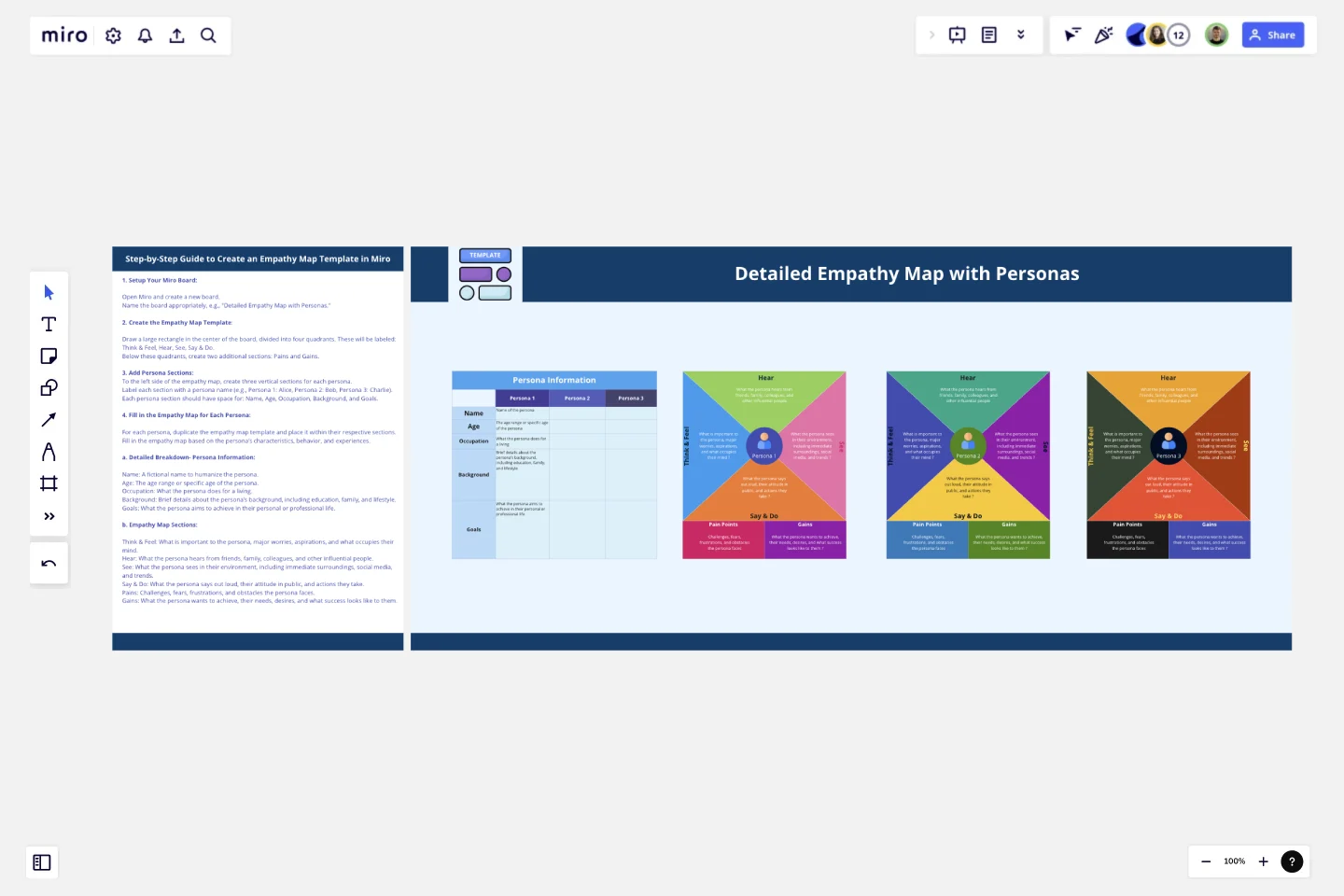Detailed Empathy Map With Personas
Importance and Uses of the Detailed Empathy Map with Personas Template
Importance
Deep Understanding of Users:
The empathy map helps in gaining a profound understanding of the users' needs, motivations, and experiences. It allows you to step into their shoes and see the world from their perspective.
Enhanced Product Development:
By understanding what users think, feel, see, hear, say, and do, you can create products and services that truly resonate with them. This ensures that the end product is user-centric and meets their expectations.
Improved Communication:
Empathy maps facilitate better communication within the team by providing a clear, visual representation of user personas. This helps align everyone's understanding and keeps the team focused on the user's needs.
Identifying Pain Points and Gains:
The template helps in identifying user pain points and what they want to achieve (gains). This information is crucial for addressing user challenges and enhancing their overall experience.
Informed Decision Making:
With detailed personas and empathy maps, decision-making becomes more informed and data-driven. It helps in prioritizing features, making design choices, and planning marketing strategies based on real user insights.
Increased User Engagement:
Understanding users on a deeper level allows you to create more engaging and relevant content, products, and services. This leads to increased user satisfaction and loyalty.
Uses
Product Development and Design:
Utilize the empathy map to guide product development teams in creating user-centric products. It ensures that the design and functionality align with user needs and preferences.
Marketing and Communication:
Use the personas and empathy maps to develop targeted marketing campaigns. Understanding the users’ thoughts, feelings, and behaviors helps in crafting messages that resonate with them.
Customer Journey Mapping:
Integrate empathy maps into customer journey mapping to visualize the entire user experience. This helps in identifying touchpoints, pain points, and opportunities for improvement.
User Research and Analysis:
Employ empathy maps as a tool for organizing and analyzing user research data. It helps in summarizing qualitative research findings and presenting them in a structured manner.
Stakeholder Alignment:
Share empathy maps with stakeholders to ensure everyone has a unified understanding of the target users. This fosters collaboration and consensus on user-centered goals and strategies.
Training and Onboarding:
Use the template to train new team members about the target audience. It provides a comprehensive overview of the users, helping newcomers quickly get up to speed with user-centric approaches.
Innovation and Ideation:
Leverage empathy maps during brainstorming sessions to generate innovative ideas that address real user needs. It provides a user-focused lens for creative problem-solving.
Service Design:
Apply the empathy map in service design to enhance user experiences across various touchpoints. It helps in designing services that are intuitive, efficient, and user-friendly.
By incorporating detailed empathy maps and personas into your processes, you can create more effective, user-centered solutions that drive engagement, satisfaction, and success.
This template was created by Khawaja Rizwan
Get started with this template right now.
Workflow Diagram Template
Works best for:
Diagramming, Mapping, Process mapping
The Workflow Diagram Template maps out and represents processes or systems using standardized symbols and shapes. By delineating the various steps or stages in a process, it ensures that tasks flow seamlessly from initiation to completion. One of the standout benefits of using this template is its clarity. By translating processes into a visual format, all participants can gain a comprehensive understanding at a glance, eliminating confusion and ensuring everyone is on the same page. This clarity not only promotes efficient task execution but also fosters collaboration among team members.
UML Sequence Deployment Pipeline Template
Works best for:
UML
The UML Sequence Deployment Pipeline Template in Miro visually maps the sequence of steps in an automated deployment pipeline, helping teams in software development and deployment. It helps identify bottlenecks, standardizes the deployment process, and facilitates new member onboarding for continuous improvement.
Swim Lane Diagram with Data
Works best for:
Flowchart, Mapping, Diagrams
The Swim Lane Diagram with Data template is a visual tool for illustrating processes or workflows with swimlanes that contain additional data or information. It provides elements for documenting process steps, timelines, and performance metrics within each swimlane. This template enables teams to analyze process efficiency, identify bottlenecks, and make data-driven decisions for process improvement. By combining visual clarity with data insights, the Swim Lane Diagram with Data empowers organizations to optimize workflows and drive continuous improvement effectively.
Service Blueprinting Workshop
Works best for:
Agile
The Service Blueprinting Workshop template helps teams visualize and improve service processes. It includes ice breakers, context canvas, empathy maps, and action plans for service transitions. Use it to align teams, identify opportunities, and prototype service delivery from a macro to microscopic level, ensuring a comprehensive understanding of service orchestration and seamless collaboration. Ideal for remote and dispersed teams.
Product Roadmap Canvas Template
Works best for:
Roadmap, Mapping, Planning
The IASA - Product Roadmap Canvas template offers a holistic view of product development by integrating key elements such as customer needs, business goals, and technology requirements. By utilizing this canvas, teams can align their product strategy with market demands and ensure that development efforts are focused on delivering maximum value to customers.
Recruitment Strategy Roadmap
Works best for:
Roadmap, Planning, Mapping
The Recruitment Strategy Roadmap template helps organizations plan and execute their talent acquisition initiatives effectively. It provides a structured framework for identifying hiring needs, sourcing candidates, and evaluating recruitment channels. By aligning recruitment efforts with business objectives, organizations can attract and retain top talent, driving organizational growth and success.
